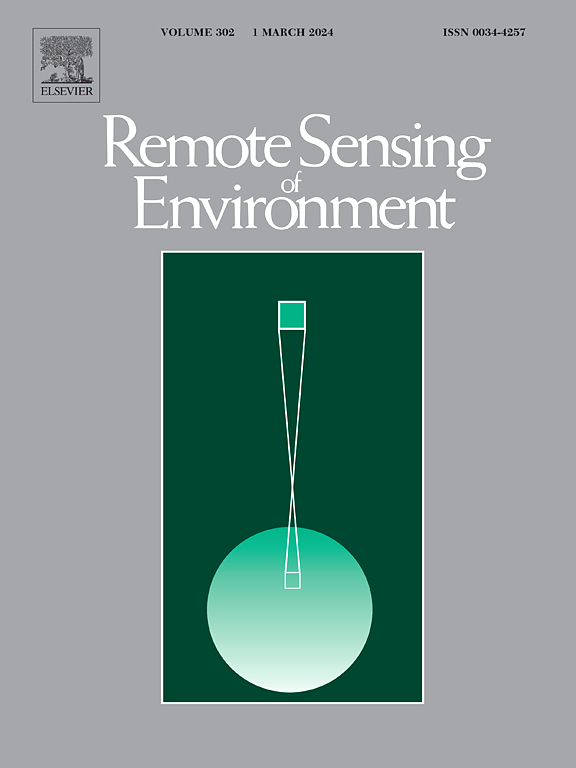A temporal attention-based multi-scale generative adversarial network to fill gaps in time series of MODIS data for land surface phenology extraction
IF 11.1
1区 地球科学
Q1 ENVIRONMENTAL SCIENCES
引用次数: 0
Abstract
High-quality and continuous satellite data are essential for land surface studies such as monitoring of land surface phenology, but factors such as cloud contamination and sensor malfunction degrade the quality of remote sensing images and limit their utilization. Filling gaps and recovering missing information in time series of remote sensing images are vital for a wide range of downstream applications, such as land surface phenology extraction. Most existing gap-filling and cloud removal methods focus on individual or multi-temporal image reconstruction, but struggle with continuous and overlapping missing areas in time series data. In this study, we propose a Temporal Attention-Based Multi-Scale Generative Adversarial Network (TAMGAN) to reconstruct time series of Moderate Resolution Imaging Spectroradiometer (MODIS) data. TAMGAN leverages a Generative Adversarial Network (GAN) with a 3-dimensional Convolution Neural Networks (3DCNN) in its generator to reconstruct the missing areas in the annual time series of remote sensing images simultaneously. The temporal attention blocks are designed to capture the changing trends of surface reflectance over time. And multi-scale feature extraction and progressive concatenation are introduced to enhance spectral consistency and provide detailed texture information. Experiments are carried out on MOD09A1 products to evaluate the performance of the proposed network. The results show that TAMGAN outperformed the comparison methods across various evaluation metrics, particularly in handling large and continuous missing areas in the time series. Furthermore, we showcase an example of downstream application by extracting phenological information from the gap-filled products. By effectively filling gaps and removing clouds, our method offers spatial-temporal continuous MODIS surface reflectance data, benefiting downstream applications such as phenology extraction and highlighting the potential of artificial intelligence technique in remote sense data processing.
基于时间关注的多尺度生成对抗网络填补MODIS数据时间序列空白,用于地表物候提取
高质量和连续的卫星数据对于监测地表物候等陆地表面研究至关重要,但云污染和传感器故障等因素降低了遥感图像的质量并限制了它们的利用。在时间序列遥感图像中填补空白和恢复缺失信息对于陆地表面物候特征提取等下游广泛应用至关重要。现有的空白填充和去云方法大多侧重于单个或多时间图像的重建,但难以处理时间序列数据中连续和重叠的缺失区域。在这项研究中,我们提出了一种基于时间注意力的多尺度生成对抗网络(TAMGAN)来重建中分辨率成像光谱仪(MODIS)数据的时间序列。TAMGAN利用生成器中的生成对抗网络(GAN)和三维卷积神经网络(3DCNN)同时重建遥感图像年度时间序列中的缺失区域。时间注意块的设计是为了捕捉表面反射率随时间的变化趋势。引入多尺度特征提取和逐级拼接,增强了光谱一致性,提供了详细的纹理信息。在MOD09A1产品上进行了实验,以评估所提出网络的性能。结果表明,TAMGAN在各种评估指标上都优于比较方法,特别是在处理时间序列中大而连续的缺失区域方面。此外,我们还展示了一个下游应用的例子,即从空白填充的产品中提取物候信息。通过有效地填补空白和去除云层,我们的方法提供了时空连续的MODIS地表反射率数据,有利于物候提取等下游应用,并突出了人工智能技术在遥感数据处理中的潜力。
本文章由计算机程序翻译,如有差异,请以英文原文为准。
求助全文
约1分钟内获得全文
求助全文
来源期刊

Remote Sensing of Environment
环境科学-成像科学与照相技术
CiteScore
25.10
自引率
8.90%
发文量
455
审稿时长
53 days
期刊介绍:
Remote Sensing of Environment (RSE) serves the Earth observation community by disseminating results on the theory, science, applications, and technology that contribute to advancing the field of remote sensing. With a thoroughly interdisciplinary approach, RSE encompasses terrestrial, oceanic, and atmospheric sensing.
The journal emphasizes biophysical and quantitative approaches to remote sensing at local to global scales, covering a diverse range of applications and techniques.
RSE serves as a vital platform for the exchange of knowledge and advancements in the dynamic field of remote sensing.
 求助内容:
求助内容: 应助结果提醒方式:
应助结果提醒方式:


